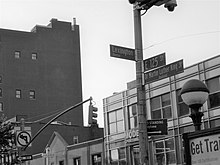I'm waiting for the man
| I'm waiting for the man | |
|---|---|
| The Velvet Underground | |
| publication | March 1967 |
| length | 4:37 |
| Genre (s) | Garage rock , protopunk |
| Author (s) | Lou Reed |
| Publisher (s) | Verve Records |
| album | The Velvet Underground & Nico |

I'm Waiting For The Man is a song by the American rock band The Velvet Underground . It was written by Lou Reed . The song first appeared in 1967 on their debut album The Velvet Underground & Nico ; In 1971 it was released as a single by MGM Records along with There She Goes Again .
Musically a simple rock song, which is accompanied by four major chords in a staccato rhythm, the song describes how a white junkie in Harlem buys heroin . The "man" named in the title is the African American dealer .
Emergence
Reed wrote I'm Waiting For The Man in 1965 when he was a heroin addict himself. A first version was recorded in the same year in the loft on Ludlow Street in the Lower East Side , New York City , shared by Reed and John Cale . Sterling Morrison was also involved in it. The arrangement, which initially managed without drums or percussion , was reminiscent of a country blues and contained a harmonica - and a viola solo . Reed was heavily influenced by Bob Dylan at the time . Three takes of this version were released on the 1995 compilation Peel Slowly and See . The next version was recorded in April 1966 at the Scepter Records studio in New York. It corresponds roughly to the LP version that was recorded a month later in the TTG Studios in Hollywood , but was shorter and instead of Maureen Tucker's drums contained a tambourine as a rhythm instrument. The final instrumentation was now reduced to guitar, piano, bass and drums; There were no more solos. The song was produced by the band itself; The Andy Warhol mentioned on the LP had, as Reed reported in a later interview, the sole function of preventing third-party interference through his mere name.
text
The text describes from a first-person perspective how an addict junkie waits for his dealer at the intersection of Lexington Avenue and 125th Street in African-American Harlem to buy heroin for $ 26 . A passerby aggressively suspects him of having come to Uptown for the women , but can be reassured. The dealer appears late in flashy clothes, and the addict hurries to the stairwell of one of the typical Harlem brownstone houses to take a shot. Then he feels good and is temporarily optimistic about the future. Reed later claimed that the situation described in the text existed “except for the price”.
With this dark, realistic text, as well as those of other songs on the album, such as Heroin and Venus in Furs , Reed pursued the goal of bringing the literary quality and sensitivity of his favorite authors Raymond Chandler , Hubert Selby and Delmore Schwartz into pop music, wherever until then was mainly sung of heart and pain. The author Joe Harvard also sees influences from pulp magazines and the film noir and speaks of "rock noir".
Live versions
I'm Waiting For The Man was part of the standard live repertoire of the Velvet Underground. They played the song both at Exploding Plastic Inevitable , a multimedia event organized by Andy Warhol, and at later performances. Versions of the piece are included on the records Live at Max's Kansas City , on 1969: The Velvet Underground Live and on Live MCMXCIII (sung by John Cale). It can also be found on Le Bataclan '72 , which Reed and Cale recorded together with Nico in Paris in 1972 . Also on several live records that Reed made after the end of the Velvet Underground, for example on Lou Reed Live from 1975, on Live: Take No Prisoners from 1979 and on Live in Italy from 1983. John Cale released live recordings of I ' m Waiting For The Man on John Cale Comes Alive (1983) and on Live at Rockpalast (1984, released 2010).
reception
In the list of 500 best songs of all time the music magazine Rolling Stone is I'm Waiting For The Man ranked 161st
Individual evidence
- ^ Mark Deming: The Velvet Underground & Nico Review. Allmusic , accessed July 20, 2019 .
- ↑ a b c 500 Greatest Songs of All Time. Rolling Stone's definitive list of the 500 greatest songs of all time. Retrieved July 11, 2019.
- ^ A b Joe Harvard: The Velvet Underground & Nico . Bloomsbury Academic, New York / London 2013, p. 96.
- ↑ Lou Reed: The Last Interview and other Conversations. Melville House, Brooklyn / London 2015, p. 33.
- ^ Lou Reed: Texts. German by Diedrich Diedrichsen . Kiepenheuer and Witsch, Cologne 1991.
- ^ Joe Harvard: The Velvet Underground & Nico. Bloomsbury Academic, New York / London 2013, p. 70.
- ↑ Barry Graves , Siegfried Schmidt-Joos : The new rock lexicon. Rowohlt, Reinbek 1990, Volume 2, p. 834.
